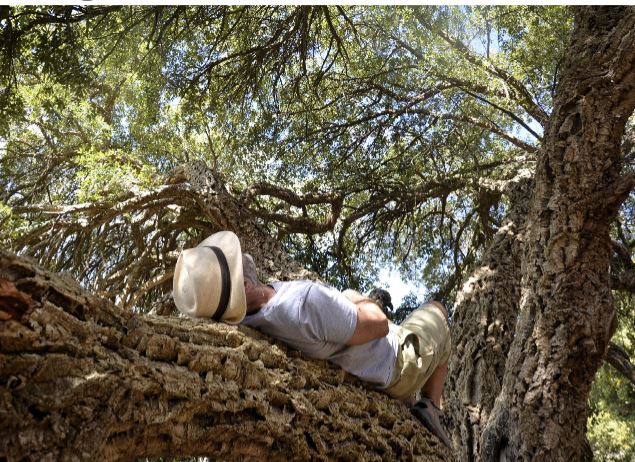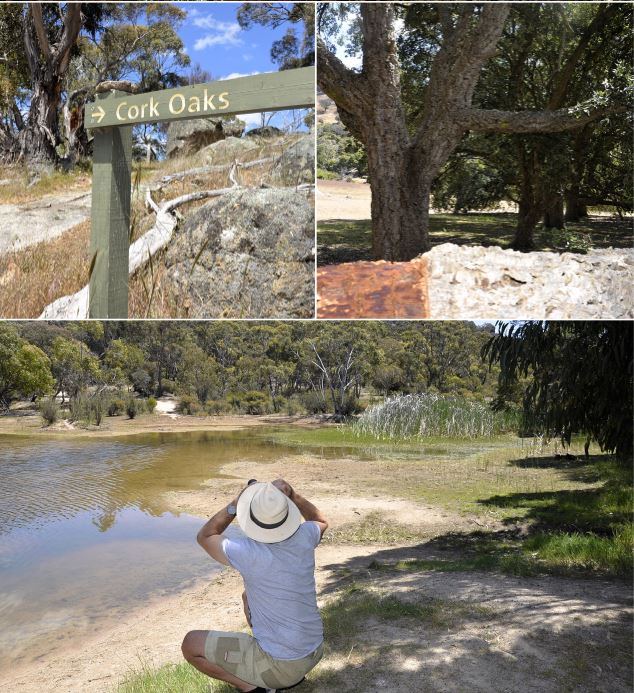December 10th, 2023Walks of the Central Highlands…
with Eve Lamb
Today we’re tackling a short sharp little gem of a walk known as The Cork Oaks Track.

Traversing the northern east-west flank of Mount Beckworth Scenic Reserve just out of Clunes this under-acknowledged little beauty is noteworthy for several reasons, the most obvious being its namesake – the cork oaks (Quercus suber). More on them when we reach them…
As mentioned, this is a short walk, only 6.5 kms the round trip, but don’t be fooled. By the time you’re finished with it you’ll feel like you’ve had a decent little workout as it does pack a couple of pulse-raising small punches of elevation.
The first challenge is getting to the starting point. We enter the Mount Beckworth Scenic Reserve at its north-eastern end, by vehicle, having driven from Clunes and taken the Maryborough Road, followed by Cemetery, Golf Course, Pickford’s and Kierces roads to reach The Dam located within in the Reserve.
There’s one or two points where extra careful driving may be called for, particularly depending on recent rainfall activity and the degree of gravel road maintenance that’s occurred since.
The Dam. This is our starting point, on the north eastern flank of Mount Beckworth. It’s a top little picnicking spot with tall native water grasses making a sweet habitat for various birds. Above us a black kite shoots the breeze and from here we first start out on the Dam Track skirting around the northern edge of The Dam itself before we encounter the first short sharp little climb.
By this stage we’ve already enjoyed plenty of native flora, eucalypts full of blossom and the drowsy afternoon drone of working bees, and some native casuarina as we climb the Beckworth lower flank with its rocky granite ridgelines.
The Oval. We reach The Oval. It’s a small flat grassy plateau offering excellent views back to the east over the volcanic plains with their ‘mammeloid’ hills rollicking away to far shimmering horizons. At this time of year, late spring, The Oval itself is a tangle of native, and some not-so-native grasses interlaced with intricate indigenous wildflowers.
From here there’s a very gentle climb, gaining great views to the west, across agricultural land and the distant Waubra wind farm towers. Leaving The Oval, we join the Yellow Box Track for a short while, and the trail weaves through splendid examples of the namesake yellow box gums and some remarkable
rocky outcrops and large boulders festooned with rugged lichens. The track is pretty well signposted and soon we find the turnoff to the Cork Oaks clearly marked ahead.
Snakes We’ve reached mid-walk, the sun’s beating down, late afternoon and, camera in hand, I’m admiring yellow native paper daisies in full brilliance and magnificent swirls of bark on old growth gums, when I almost step on a brown snake.
Fortunately it’s about as happy to see me as I am it and when I see it, all of a school ruler’s length from my boot. It’s already sliding away from me about as fast as its belly muscles can carry it. At this point, my trusty walking companion for this expedition – Paddy H – declares a lunchbreak.
Refuelled, we head on toward the Cork Oaks through an undulating and visually interesting section of trail. The woodland all around is dry but with all of those rocky boulder features and views, it’s also imposing with a grandeur all its own, not to mention generous wafts of that classic hot Aussie bushland scent that you can only get by doing exactly this.
Lucky. Having almost stepped on a highly venomous brown snake I’m pretty vigilant at this point in our trek and we count ourselves lucky to have had such a peaceable warning encounter as the track now descends toward a dry watercourse; dry yet, in late November, still green enough along its immediate riparian zone to suggest the sort of small life forms that attract plenty of hungry reptiles.
The Cork Oaks After crossing the dry creek bed there’s only a few hundred metres left to walk before we finally reach the Cork Oaks. They’re nothing if not a surprise packet out here on the western flank of the Mount Beckworth Scenic Reserve.
Prior to doing this walk I’ve done a bit of research and discovered that these 40 odd mature exotic trees were planted here back in 1965 as a then Forests Commission Victoria trial. The goal was to determine the viability of growing cork oaks (Quercus suber) for domestic commercial uses and came about following some fairly intense lobbying by a persistent and well-connected captain of industry of the day.
My research also informs that cork oaks occur naturally around the western Mediterranean and that cork from cork oaks has been used since ancient times as bottle stoppers, footwear, insulation and floats for fishing.
Since the 17th century the production and export of cork had been an important industry in Portugal and Spain, the bark first harvested when the trees were about 25 years old and thereafter at nine to 12 year intervals.
Unfortunately, it appears nothing much beyond an interesting diversion for the more horticulturally-minded boffins in the Forests Commission ever really came of the trial. Beyond the living legacy that endures of course.
Today the western edge Mount Beckworth cork oaks are one of the very few traces remaining of a handful of early cork oak trials conducted by the Forests Commission Victoria last century. This little remnant trial plot features some truly beautiful trees with their corrugated trunks and wizened leaves offering welcome shade in a frequently parched land.
We arrive and fling down our backpacks for a while to lie back in the oaks’ silvery shadows and appreciate these imposing specimens and their novel place in history, along with a well earned coffee or two.
Time slips away easily here, but don’t leave it too long to start heading back if you’ve taken on this walk toward dusk as the return leg may seem longer than you’d think, particularly the last descent from The Oval back to The Dam which can be super slippery, particularly when it’s really dry.
This is a top shelf little walk for its views and unique points of interest. If you’re sampling it in the warm part of the year, just watch out for the snakes.
Images: Eve Lamb











